Evaluation of the Business Women in International Trade Initiative, 2018-19 to 2021-22
Evaluation Report
Prepared by the Evaluation Division (PRA)
Global Affairs Canada
May 2023
Acronyms and abbreviations
- 2SLGBTQI+
- Two-spirit, lesbian, gay, bisexual, transgender, queer, intersex, and additionally sexually and gender diverse people
- BDC
- Business Development Bank of Canada
- BPE
- Inclusive Trade, FTA Promotion and Trade Missions Division
- BWIT
- Business Women in International Trade
- CRM
- Client relationship management
- EDC
- Export Development Canada
- FTA
- Free trade agreement
- FTE
- Full-time equivalent
- GAC
- Global Affairs Canada
- HQ
- Headquarters
- ISED
- Innovation, Science and Economic Development Canada
- KPI
- Key performance indicator
- OGD
- Other government department
- ROs
- Regional offices
- SMEs
- Small and medium-sized enterprises
- TCS
- Trade Commissioner Service
- TPF
- Trade Program Fund
- WES
- Women Entrepreneurship Strategy
Executive summary
This evaluation examined Global Affairs Canada’s Business Women in International Trade (BWIT) initiative for the period from fiscal year (FY) 2018-19 to FY 2021-22. The objectives of the evaluation were to highlight areas of strength and gaps in BWIT’s objectives, resources and delivery of services, and identify ways in which the BWIT initiative can maximize its results and support to businesses and partners. This report presents the evaluation findings, conclusions, recommendations and considerations for future delivery of the BWIT initiative.
This evaluation confirmed the continued relevance of the BWIT initiative, based on the needs of its target clients, the initiative’s alignment with the Government of Canada’s Export Diversification Strategy and inclusive approach to trade, and BWIT’s niche within the broader ecosystem of government support to women entrepreneurs. The initiative’s performance improved following the 2018 decentralization of its service delivery model into three distinct components, namely the headquarters (HQ) support role, the diversity champion role in regional offices and the BWIT Trade Program Fund. The Inclusive Trade Promotion team at HQ contributed to a more comprehensive approach to supporting women entrepreneurs by providing policy guidance within Global Affairs Canada and increasing the reach and awareness of Trade Commissioner Service (TCS) support for women entrepreneurs through engagement with women’s business support organizations. The creation of the client-facing diversity champion role in regional offices fostered TCS engagement with a wider subset of women and underrepresented entrepreneurs across Canada, although diversity champions were not adequately supported with sufficient strategic direction or focused training. This evaluation found that the BWIT Trade Program Fund was fundamental in enabling missions to organize initiatives promoting inclusive international trade by supporting BWIT clients in accessing diverse markets.
While the initiative demonstrated improved performance, BWIT services across its three components were not designed to systematically align with the sectors in which women entrepreneurs were mostly concentrated, limiting the extent to which services could be targeted to these groups. In addition, limitations in the collection, maintenance and extraction of disaggregated data impacted the performance measurement and implementation of the BWIT initiative. Finally, the BWIT initiative consistently underspent allocated funds due to challenges faced specifically within the evaluation period, such as COVID-19 and the non-permanent nature of BWIT-funded positions.
Summary of recommendations
- Formalize guidance and enhance support to regional offices on the diversity champion role and responsibilities in addressing the distinct needs of women entrepreneurs.
- Prioritize the selection of BWIT-Trade Program Fund initiatives that align with the sectors in which women entrepreneurs are most concentrated.
Background
Women entrepreneurship
Figure 1:
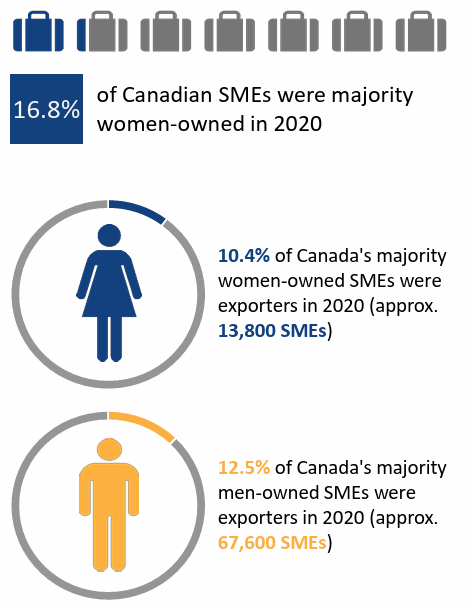
Text version
16.8% of Canadian SMEs were majority women-owned in 2020
10.4% of Canada’s majority women-owned SMEs are likely to export (approx. 13,800 SMEs)
12.5% of Canada’s majority women-owned SMEs are likely to export (approx. 67,600 SMEs)
Source: Estimates based on data from Innovation, Science and Economic Development Canada’s Survey on Financing and Growth of Small and Medium Enterprises, 2020
Women entrepreneurship in Canada
In 2020, small and medium-sized enterprises (SMEs) in Canada represented 99.8% of all employer businesses and hired 88.3% of all private sector employees. However, only 16.8% of Canadian SMEs were majority owned by women, compared to 68.9% owned by men and 14.3% owned equally by men and women. Furthermore, there remains a gender gap in the rates of exporting, with 10.4% of women majority-owned SMEs exporting compared to 12.5% for those majority owned by men in 2020. Women-owned businesses face complex challenges hindering their growth. These include limited access to innovative financing, customized or gender-sensitive counselling and mentorship, and digital and financial capacity building, as well as procedural and regulatory obstacles, and socio-cultural expectations. Narrowing the gender gap in the Canadian economy could boost Canada’s annual gross domestic product by an estimated $150 billion by 2026.
Canada’s Women Entrepreneurship Strategy
The Women Entrepreneurship Strategy (WES) was launched in 2018 and represents a whole-of-government approach to increasing women-owned businesses’ access to the financing, talent, networks and expertise they need to start-up, scale-up and access new markets. Coordinated by Innovation, Science and Economic Development Canada (ISED), the WES represents nearly $7 billion in investments and commitments from almost 20 different federal departments, agencies and Crown corporations. Amongst others, selected WES program partners include the Business Development Bank of Canada, Export Development Canada, Farm Credit Canada, Public Services and Procurement Canada, Women and Gender Equality Canada, and Global Affairs Canada. Through Budget 2021, the Government of Canada announced investments of $146.9 million over four years to further strengthen the WES.
Global Affairs Canada’s support to women exporters
Global Affairs Canada has prioritized increasing the economic engagement of underrepresented groups based on the Government of Canada’s Export Diversification Strategy, which was established in 2018 to secure more opportunities for Canadian exporters and investors in global markets. This has included an inclusive approach to trade that seeks to ensure that the benefits of trade are more widely shared, including with women, SMEs, and Indigenous peoples. Related Trade Commissioner Service programs have included CanExport and the Canadian Technology Accelerator. CanExport offers grants and contributions to Canadian companies to help them prepare for and establish a presence in international markets, including business delegations and supplier diversity certification support for underrepresented groups. The Canadian Technology Accelerator program supports high-growth, high-potential tech companies and has implemented initiatives to promote greater participation of women entrepreneurs.
The BWIT initiative
Key components of the BWIT initiative following the delivery model shift:
- HQ support to promote the enhancement of Trade Commissioner Service programming and data analysis for women exporters, and engage widely to support women entrepreneurs and develop partnerships.
- Diversity champion roles across the Trade Commissioner Service’s six regional offices dedicated to providing BWIT services.
- A BWIT Trade Program Fund established to allow trade commissioners at regional offices in Canada and missions abroad to organize initiatives for women exporters.
Business Women in International Trade program (1997 to 2018)
The Business Women in International Trade (BWIT) program was established in 1997 as a dedicated unit of the Trade Commissioner Service (TCS) to support Canadian women entrepreneurs. The program coordinated activities for women exporters, such as providing advice and guidance on navigating the TCS, distributing relevant publications and coordinating business delegations to supplier diversity events abroad. The program’s HQ-based model was client facing and exclusively focused on business women.
Business Women in International Trade initiative (2018 to present)
In 2018, Global Affairs Canada received $10 million over five years under the 2018 federal budget to expand BWIT as part of the Women Entrepreneurship Strategy coordinated by Innovation, Science and Economic Development Canada. With this funding, BWIT shifted from an HQ-based model toward an initiative more directly integrated in the Trade Commissioner Service, relying on trade commissioners in regional offices to provide support to women exporters and better leverage the wide reach of the TCS network and regional presence. BWIT-funded full-time equivalents consisted of two positions at headquarters reporting to management of the Inclusive Trade, FTA Promotion and Trade Missions Division (BPE) and six diversity champion positions in regional offices reporting to their respective senior trade commissioner.
Figure 3:
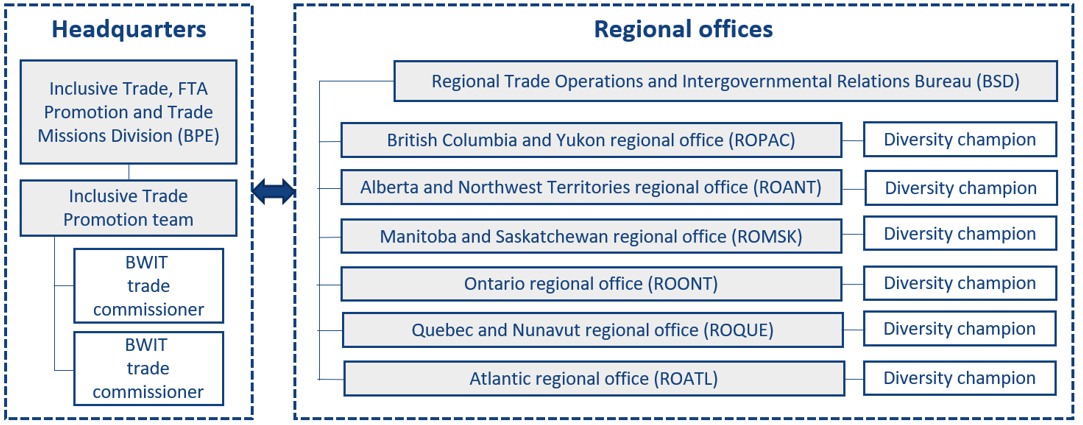
Text version
BWIT organigramme outlining the mix of positions at headquarters and regional offices.
Evaluation scope and methodology
Evaluation scope and objectives
Evaluation scope
The evaluation covers the period FY 2018-19 to 2021-22 and includes all BWIT initiative operations and activities delivered by Global Affairs Canada (GAC) at headquarters in Ottawa and in the Trade Commissioner Services’ six regional offices. It is GAC’s first evaluation of the BWIT initiative.
It also covers the initiative’s three components: the HQ support role, the BWIT Trade Program Fund and the BWIT diversity champions role.
Evaluation objectives
- Highlight areas of strength and gaps in BWIT’s objectives, resources and delivery of services.
- Identify ways in which the BWIT initiative can maximize its results and support to businesses and partners.
- Provide neutral evidence to inform the renewal application process for the BWIT initiative.*
*Funding for the BWIT initiative expired on March 31, 2023. At the time of writing this report, BPE obtained bridge funding to support the initiative for an additional six months while seeking permanent funding beyond this date.
Evaluation features
- Utilization focus. As a utilization-focused evaluation, this evaluation was planned and conducted to enhance the likely utilization of both the findings and the process itself to inform decision making and improve the BWIT initiative’s performance. As such, at BPE’s request, the evaluation team conducted initial research and shared preliminary findings early in the evaluation process in June 2022, to inform the BWIT funding renewal process. The evaluation team also collaborated with GAC’s Knowledge Translation Unit to develop an evaluation learning and influence plan to respond to the information needs of both internal and external stakeholders where possible.
- Feminist approach. The evaluation incorporated feminist evaluation principles to better meet the needs of relevant stakeholders and ensure that the voices of underrepresented groups are prioritized and incorporated. This included the development and application of an implementation plan for applying feminist evaluation principles and elements throughout the different phases of the evaluation. The evaluation team also engaged directly with women and underrepresented entrepreneurs at trade events and strived to obtain and incorporate disaggregated data for different underrepresented groups (see Annex 3 for details on the feminist evaluation approach).
- Innovative data collection.To adapt data collection to the time constraints of women and other underrepresented entrepreneurs, the evaluation team developed short “rapid interview” questionnaires consisting of a limited number of questions to conduct 5- to 10-minute rapid interviews with these entrepreneurs at in-person events. This approach allowed for rapid data collection in a fast-paced environment (e.g. trade shows) and coverage of multiple stakeholders and interviews in a limited amount of time. These rapid interviews were successfully piloted at two trade-related events, in Orlando and Toronto.
Evaluation questions
| Questions |
|---|
Relevance |
Q1. To what extent is there an ongoing need for the Business Women in International Trade (BWIT) initiative?
|
Efficiency |
Q2. To what extent has the delivery of the BWIT initiative been efficient?
|
Effectiveness - Results |
Q3. To what extent has the BWIT initiative achieved its intended results?
|
Methodology
The evaluation used a mixed-methods approach, where data was collected from a range of sources to ensure multiple lines of evidence when analyzing data and formulating findings. Each finding was triangulated using evidence from a mix of quantitative and qualitative data. Eight main methods were used for the evaluation:
Document review
Review of internal GAC documents on policies, systems and processes, planning and strategy documents, as well as guidance, reports, briefing notes, templates, tools, etc.
- 37 BWIT-specific documents
- 41 TCS and GAC documents
Literature review
Review of external literature, documents and statistics on women and other underrepresented entrepreneurs, including barriers to international trade, and domestic trends for women exporters:
- 85 external reports and publications reviewed
Domestic environmental scan
A scan of the ecosystem of Government of Canada initiatives or programs supporting women and underrepresented entrepreneurs. The scan covered:
- 12 other government departments, agencies and crown corporations
- 7 regional development agencies
- 3 national or regional business associations
International environmental scan
A scan of best practices from relevant initiatives in four countries: Chile, Ireland, New Zealand, and the United States:
- 7 interviews with stakeholders
- 6 consultations with Canadian mission staff and other stakeholders
- 87 program and policy documents and websites reviewed
Financial and reporting data review
Review of available data related to BWIT, including:
- TRIO reporting data
- BWIT performance data
- TCS client survey data
- TCS Trade Program Funds data
- chief financial officer financial data
Interviews
83 semi-structured individual or small group interviews (and written responses) with:
- 46 GAC staff (HQ, regional offices, missions, other initiatives)
- 12 OGDs, agency, crown corporation or regional development agency staff
- 13 women entrepreneurs (TCS clients and non-clients)
- 12 business support organizations and certifying body staff
Trade-related event data collection
The evaluation team attended and collected data at two virtual and two in-person trade-related events, during which the team conducted:
- 42 rapid interviews with women entrepreneurs (TCS clients and non-clients)
- 37 event session observations
- 1 focus group discussion
Case studies
Conducted case studies on three key BWIT components:
- the BWIT HQ support role
- the BWIT Diversity Champion roles across the TCS’s six regional offices
- the BWIT Trade Program Fund
Evaluation limitations and mitigation measures
| Limitations | Mitigation measures |
|---|---|
Performance and reporting data quality and disaggregation As an initiative integrated into the Trade Commissioner Service, BWIT relied on the TRIO system for reporting activities, which was not designed to capture data on all underrepresented groups nor to easily identify BWIT-specific activities. There was also no process in place to ensure underrepresented groups were accurately tagged and intersectional data captured. The BWIT-Trade Program Fund financial and initiatives data was subject to data quality limitations. | Triangulation of data sources and use of best available data The evaluation team drew from TRIO data to the extent possible, but also relied on other data sources to address gaps and limitations and provide more context. This included Trade Commissioner Service client survey results, a mini survey of diversity champions, case studies, interviews and document review. The evaluation team reviewed the most robust financial data available. |
Limited access to stakeholders The evaluation team had limited access to underrepresented entrepreneurs and other stakeholders such as mission staff and other government departments, who were geographically dispersed and whose availability was often constrained by competing priorities and multiple engagements or other commitments. | Use of appropriate data collection methods The evaluation team adapted its data collection to reduce the time burden on stakeholders. This included traveling to events attended by underrepresented entrepreneurs, and using rapid interview questionnaires to collect data in a way that was less time intensive. The option of providing written responses was also provided. |
Timing of the BWIT initiative evaluation The renewal application process for the BWIT initiative took place before the BWIT evaluation could be completed, which limited GAC’s ability to fully utilize the evaluation findings and evidence to inform the renewal application. | Development of a preliminary findings paper in June 2022 The evaluation team conducted initial research and developed a preliminary findings paper early in the evaluation process (June 2022) to provide neutral evidence that was used to inform BWIT’s funding renewal process. |
Findings
Relevance
Trade-related needs and barriers
Figure 4:
Key barriers for women entrepreneurs in Canada

Text version
Key barriers for women entrepreneurs in Canada:
- Limited confidence
- Access to financing / Capital
- Systemic biases / Social perception
- Lack of information / Knowledge
- Time / Resource constraints
- Access to training / Mentorship
- Lack of networks
- Access to international markets
- Limited development of business skills / Competencies
- Family obligations
Source: Multiple sources (see Annex 5)
There is a continued and ongoing need for specialized support for women entrepreneurs and other underrepresented groups to support their access to international trade.
Of the Canadian majority women-owned businesses in 2020, 96% were SMEs, which are the target client base of the Trade Commissioner Service (TCS). Despite women-owned SMEs exporting proportionally less than men-owned SMEs (as previously noted), on average, they achieve a relatively higher financial return when they adopt an intensive export strategy. This positions the TCS, and particularly BWIT, to address the needs of women entrepreneurs, who are more likely to own newer and smaller businesses and less likely to export than men-owned businesses. Canadian women entrepreneurs face persistent barriers when engaging in international trade, indicating a continued and ongoing need for the BWIT initiative. While some barriers to export for Canadian SMEs cut across all categories of gender ownership, they tend to be accentuated for women. Women also face barriers that require specific types of support. According to research from GAC’s Office of the Chief Economist, logistical obstacles were perceived as being the most prohibitive barrier to export across genders, with domestic administrative obstacles being the next most important barrier for both women and men. Foreign administrative obstacles, border issues and market knowledge ranked as the next most important obstacles specifically for women-owned businesses in entering export markets. These are all barriers for which the TCS could play a role by providing information to women entrepreneurs. Other barriers identified by women entrepreneurs included limited trade-related knowledge and capacity, limited access to networks, and societal perceptions of women.
Though BWIT’s mandate focused on serving women entrepreneurs, it was inclusive enough to take into account the intersectional identities of women identifying with other underrepresented groups in trade, which increased the initiative’s relevance given the diverse challenges faced by these groups. For Indigenous entrepreneurs, challenges include a lack of reliable access to infrastructure and broadband, the high cost of living and doing business in the North and systemic and institutional constraints, as well as racism. For Black and other racialized entrepreneurs, challenges include weaker networks, access to capital and less history of loans and assets, lack of access to mentoring, information and business skills development support, as well as systemic discrimination and racism. For 2SLGBTQI+ entrepreneurs, main challenges are the stigma of self-identification and systemic discrimination based on gender, gender identity and sexual orientation. For youth entrepreneurs, challenges include lack of access to financing (e.g. limited credit history and collateral), age discrimination, lack of awareness of self-employment options and limited confidence and mentorship. This indicates the need for an initiative such as BWIT that allows for addressing the intersectional barriers of women entrepreneurs from one or a combination of underrepresented groups.
Policy alignment
Figure 5:
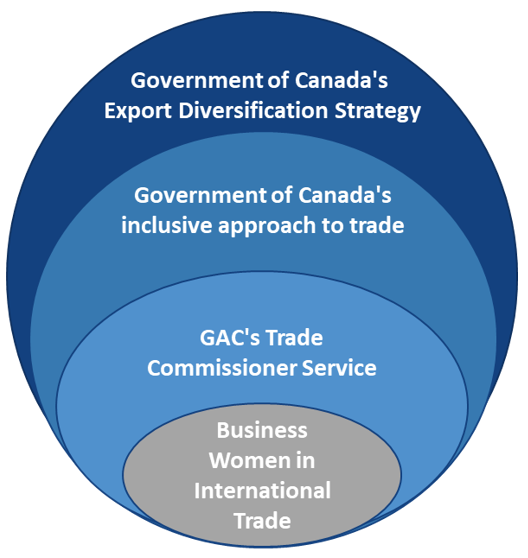
Text version
- Government of Canada’s Export Diversification Strategy
- Government of Canada’s inclusive approach to trade
- GAC’s Trade Commissioner Service
- Business Women in International Trade
- GAC’s Trade Commissioner Service
- Government of Canada’s inclusive approach to trade
The BWIT initiative was aligned with the Government of Canada's Export Diversification Strategy and inclusive approach to trade.
BWIT’s mandate was aligned with the Government of Canada's Export Diversification Strategy and inclusive approach to trade, as it supported underrepresented entrepreneurs with the resources needed to successfully access global markets. As a partner program of the Women Entrepreneurship Strategy (WES), BWIT collaborated with other government departments (OGDs) to deliver sustainable and coordinated programs to support women entrepreneurs and address the barriers they faced and worked with organizations in the broader national ecosystem of support for gender equality via economic empowerment. BWIT received funding as part of the WES and engaged with OGDs to align Government of Canada efforts to achieve full and equal participation of women in the economy. Represented by its Chief Trade Commissioner, Global Affairs Canada was also a core member of the WES Assistant Deputy Minister Interdepartmental Steering Committee created in 2018. The committee has met on a quarterly basis to ensure a coordinated, whole-of-government approach to implementation of the WES, and alignment with other Government of Canada initiatives relating to women and women entrepreneurs.
By supporting women entrepreneurs and equity-seeking groups to pursue business opportunities abroad and to access international markets, BWIT helped diversify Canada’s trade activities abroad and consequently reinforced its alignment with the Export Diversification Strategy and inclusive approach to trade. Therefore, the BWIT initiative was well positioned to further the advancement of inclusive international trade. Annex 4 outlines relevant initiatives to advance inclusive international trade from a sample of peer countries.
What is the Government of Canada’s inclusive approach to trade?
As part of its Export Diversification Strategy, the Government of Canada is pursuing an inclusive approach to trade that seeks to ensure that more Canadians have access to the benefits and opportunities that flow from international trade and investment. This includes those Canadians who have traditionally been underrepresented in international trade and investment, including women, SMEs, Indigenous Peoples, visible minorities, youth and 2SLGBTQI+. This means seeking trade policies that are sustainable, responsible, transparent and inclusive. Canada is committed to pursuing an inclusive approach to trade in recognition that trade policies and agreements need to respond and contribute more meaningfully to broader economic, social and environmental policy priorities.
Source: Global Affairs Canada. “Canada’s inclusive approach to trade.” Accessed from international.gc.ca
Government of Canada complementarity
Figure 6:
Complementary OGDs sampled for the evaluation
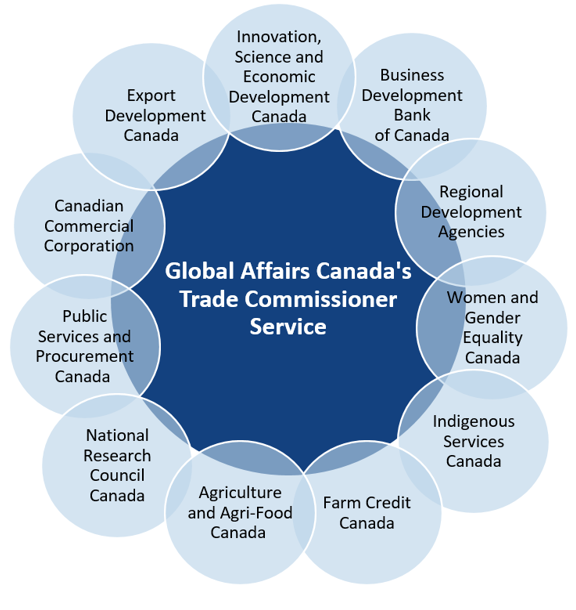
Text version
Complementary OGDs to Global Affairs Canada’s Trade Commissioner Service sampled for the evaluation:
- Innovation, Science and Economic Development Canada
- Business Development Bank of Canada
- Export Development Canada
- Canadian Commercial Cooperation
- Public Services and Procurement Canada
- National Research Council Canada
- Agriculture and Agri-Food Canada
- Farm Credit Canada
- Indigenous Services Canada
- Women and Gender Equality Canada
- Regional Development Agencies
BWIT's complementarity with other government departments and other Global Affairs Canada trade programs allowed it to fill a programming gap with relevant and targeted support for women entrepreneurs.
The BWIT initiative was largely complementary to other Global Affairs Canada (GAC) trade programs and other government departments (OGDs) programs supporting entrepreneurs, including women, both domestically and internationally. It provided differentiated services to a dedicated audience, thereby filling a gap in programming. BWIT's distinct focus on facilitating the entry and access to international markets for export-ready women entrepreneurs differed from services provided by OGDs (including those who were part of the Women Entrepreneurship Strategy coordinated by Innovation, Science and Economic Development Canada) focused on supporting domestic trade, supply chains or export readiness. By leveraging regional office and mission networks and focusing on business connections and foreign market networking opportunities, BWIT was complementary to Export Development Canada (EDC), which focused on providing digital trade knowledge, financial solutions, equity and insurance to entrepreneurs including (but not exclusively focused on) women. BPE also engaged in joint presentations with EDC and the Business Development Bank of Canada at business events on their specific roles in supporting entrepreneurs. BWIT’s mandate also complemented Canada’s seven regional development agencies which were focused on creating regional economic assets and export-readiness (though not international trade per se); BWIT interaction with them, however, was limited.
As the only sector-agnostic and national-level Trade Commissioner Service initiative providing targeted services to women-owned businesses in international trade, BWIT complemented other TCS programs like the Canadian Technology Accelerator (CTA) (focused on technology companies), the CanExport SMEs program (focused on financing international market access for SMEs) and the Canadian International Innovation Program (focused on R & D support). While TCS programs like the CTA and CanExport SMEs included some components to support women entrepreneurs, only BWIT services were focused on this target group. BWIT was more complementary and collaborated more closely with the CTA and CanExport SMEs programs, including by sharing clients and BPE providing advice on various issues to improve their programming. For instance, through consultations, BPE advised CanExport SMEs program to include supplier diversity certification costs in its eligible expenses, which was implemented and noted as a positive change by several stakeholders. Other examples of collaboration with CanExport SMEs program included fast-tracking application for women and underrepresented entrepreneurs and lowering the threshold for these groups to receive funding.
Results and delivery
BWIT performance
Highlights of BWIT’s improved performance over the evaluation period
- Women-owned TCS business clients increased by 333%.
- Commercial successes of women-owned TCS business clients increased by 248%.
- Number of annual BWIT business delegations increased by 138%.
- Services delivered to women-owned TCS business clients increased by 55%.
- Number of markets reached increased by 33%.
Source: Global Affairs Canada. Results data. 2022
The decentralization of BWIT’s service delivery from HQ to regional offices improved the initiative’s performance.
BWIT’s decentralized delivery model enabled teams at both HQ and regional offices to focus on their comparative strengths, with the HQ-based Inclusive Trade Promotion Division undertaking a policy role at the national level and diversity champions (which are trade commissioners in the regional offices providing dedicated services to inclusive trade groups) focused on client-facing responsibilities at the regional level. After decentralization, the number of women-owned TCS business clients increased from 372 in FY 2018-19 to 1610 in FY 2021-22 (a 333% increase). The number of BWIT business delegations conducted annually consistently surpassed the target of 4 to 6, ranging from 8 business delegations in FY 2018-19 to 19 in FY 2021-22 (a 138% increase). The number of markets reached through the business delegations increased from 12 markets in FY 2018-19 to 16 markets in FY 2021-22 (a 33% increase). Services delivered to women-owned business clients by the TCS increased from 2255 in FY 2018-19 to 3491 in FY 2021-22 (a 55% increase), surpassing the target, 2110, by 65%. Commercial successes of women-owned business clients rose from 40 in FY 2018-19 to 139 in FY 2021-22, surpassing the target for FY 2021-22 by 248%.
While most key performance indicators (KPIs) improved over the evaluation period, between fiscal years 2019-20 and 2020-21 there was a drop in the number of TCS services delivered to women-owned business clients, the number of commercial opportunities pursued by Canadian women-owned business clients with the assistance of the TCS, and the number of concluded commercial agreements facilitated by the TCS with a woman-owned Canadian business client. This is likely due to the COVID-19 pandemic, which was the most cited cause of project cancellation in those years. However, these numbers increased and met targets by FY 2021-22.
Spotlight: Go for the Greens 2022

One of BWIT’s flagship initiatives was providing support to Go for the Greens, an annual multi-sector women in business conference in Orlando, Florida. In 2022, a delegation of 34 Canadians attended the event to network with large corporations offering supplier diversity programs and other SMEs. Of the Canadian women entrepreneurs surveyed after the event, 85% stated that the conference either met or exceeded their expectations, while 92% noted that the Canadian government employees (BPE staff and Trade Commissioners at mission) involved in organizing the event were “approachable, helpful and easily accessible.”
Delivery model shift – HQ
Figure 7:
As part of the BWIT initiative, event agreements were organized with the following women’s business support organizations*:
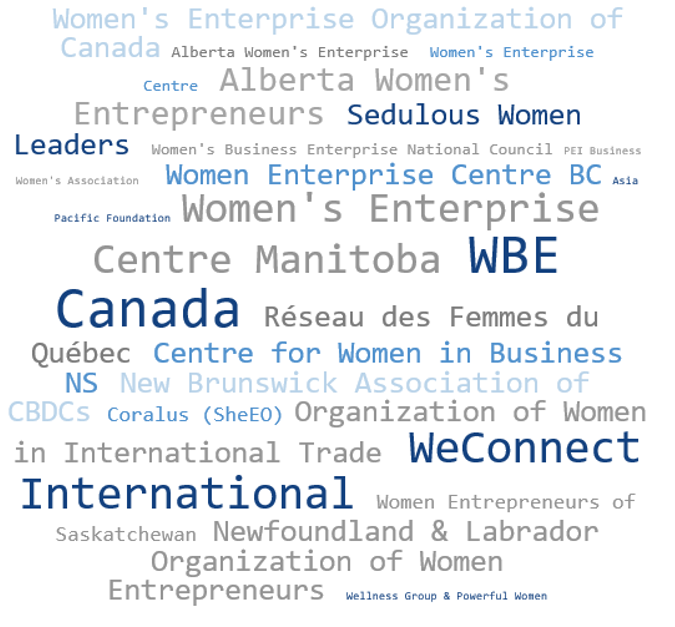
Text version
As part of the BWIT initiative, event agreements were organized with the following women’s business support organizations:
- WBE Canada
- WeConnect International Canada
- Women’s Enterprise Centre Manitoba
- Alberta Women’s Entrepreneurs
- Women’s Enterprise Centre BC
- Sedulous Women Leaders
- Réseau des Femmes du Québec
- Centre for Women in Business NS
- New Brunswick Association of CBDCs
- Organization of Women in International Trade
- Women’s Enterprise Organization of Canada
- Newfoundland & Labrador Organization of Women
- Coralus (formerly SheEO)
- Women Entrepreneurs of Saskatchewan
- Alberta Women’s Enterprise
- Women’s Business Enterprise National Council
- PEI Business Women’s Association
- Asia Pacific Foundation
- Wellness Group & Powerful Women
*The size of the organization names corresponds with the value of the event agreement(s) coordinated with that organization over the evaluation period. The values ranged from $1,500 to $49,000.
BPE’s inclusive trade promotion within Global Affairs Canada had a tangible impact on policy and programming targeting women entrepreneurs.
BPE provided policy guidance on inclusive trade within Global Affairs Canada by developing briefing material as needed for senior officials for events, budget requests and proposals related to supporting women entrepreneurs. BPE frequently shared information with the Trade Agreements Secretariat Division (TCT) to encourage inclusive trade promotion, including through consultations with TCT on inclusive trade chapters. BPE also engaged with the Foreign Policy Planning Division, including through consultations to ensure that inclusive trade was integrated into Canada’s Feminist Foreign Policy papers. BPE’s policy support function also influenced changes made to CanExport Programs Division’s (BSC’s) SMEs sub-program in a way that improved the accessibility of BWIT business delegations for underrepresented groups. Changes included the exceptional acceptance of funding applications of less than the standard requirement ($20,000), fast-tracking applications for women applying for business delegations initiated by BPE and including supplier diversity certification as an eligible cost. A tangible impact of BPE’s policy support was the use of CanExport SMEs funding by approximately one third of surveyed women entrepreneurs who attended the BWIT-supported Go for the Greens event in 2022.
BPE increased the reach and awareness of Trade Commissioner Service support for women entrepreneurs by engaging with women’s business support organizations.
BPE engaged with women’s business support organizations and participated in their events (e.g. through presentations and trade booths) to promote TCS services for women entrepreneurs pursuing international trade. As part of the BWIT initiative, $349,000 was spent on event agreements with these organizations. The cumulative membership of all Canadian women’s business support organizations with event agreements organized through the BWIT initiative exceeded 55,000, which demonstrated the capacity for such engagement to increase the reach and awareness of TCS services to women entrepreneurs. Of the women entrepreneur interviewees who had heard about BWIT prior to engaging in business delegations, 58% heard about it through women’s business support organizations, which exemplified the added value of BPE’s engagement with these organizations for raising awareness of TCS support. While some of the organizations noted that BPE’s communication regarding BWIT’s delivery model shift was limited, engagement over the evaluation period was generally considered beneficial to the ecosystem of support for underrepresented entrepreneurs, as demonstrated by the TCS being awarded the President’s Award at Women Business Enterprises (WBE) Canada’s 2022 conference. BPE accepted the award, which recognized significant contribution in supplier diversity benefiting and promoting Canadian women-owned businesses, on behalf of the TCS.
Delivery model shift – Diversity champions
Diversity champions wear multiple “hats” as trade commissioners within the regional offices with the added responsibility of serving underrepresented groups in international trade, namely women, Indigenous peoples, youth, 2SLGBTQ+ and Black and other racialized entrepreneurs.
Figure 8:
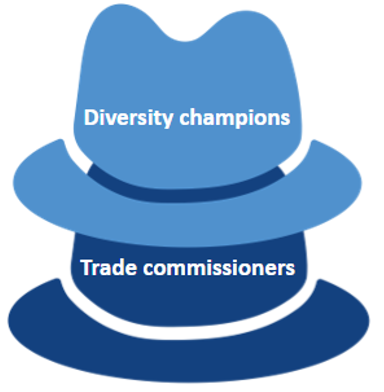
Text version
A diversity champion hat sits on top of a trade commissioner hat.
BWIT’s creation of the diversity champion role in regional offices fostered Trade Commissioner Service engagement with a wider subset of women and underrepresented entrepreneurs across Canada.
The creation of the diversity champion roles located in the six regional offices of the Trade Commissioner Service facilitated the implementation of Canada’s Export Diversification Strategy and inclusive approach to trade at the regional scale. While the BWIT initiative primarily targeted women entrepreneurs, diversity champions served not only women entrepreneurs but other underrepresented groups as well, namely Indigenous peoples, 2SLGBTQI+, youth and Black and other racialized entrepreneurs. The presence of diversity champions at regional offices created a space for women and underrepresented entrepreneurs to receive support dedicated to their needs when using services offered by the TCS. The advantage of diversity champions being based in regions was that they were better placed for accomplishing client-facing tasks and understanding client needs within the realities of their geographic context. The diversity champions had regionally pertinent contacts and experience that would be harder to establish from headquarters and were better able to engage with entities in the regional ecosystems. This facilitated collaboration with other organizations also involved in supporting women and underrepresented entrepreneurs.
Diversity champions leveraged the freedom to define and operationalize targeted support to women and underrepresented entrepreneurs in their respective regions. Examples of tailored responsiveness included the creation of a dashboard that enhanced expediency in communicating with women and underrepresented entrepreneurs, maintaining evergreen documents compiling information/resources useful for women and underrepresented entrepreneurs, and the regular maintenance of lists of women and underrepresented entrepreneurs allowing for more organized storage of client information.
Figure 9:
TCS regional offices
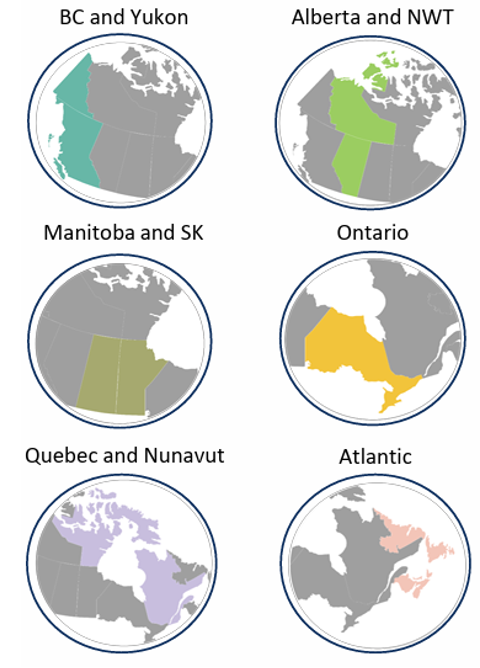
Text version
Maps identifying the Canadian regions served by each of the Trade Commissioner Service regional offices, i.e. BC and Yukon; Alberta and NWT; Manitoba and Saskatchewan; Ontario; Quebec and Nunavut; and Atlantic.
Source: Global Affairs Canada. Regional Network and Intergovernmental Relations. 2022
Diversity champions reported to their respective regional office management staff, which allowed for flexibility across the regional offices in the application of the role but limited BPE’s oversight of services.
Though their role was created using BWIT initiative funding, diversity champions reported to their respective management at regional offices (ROs). This allowed for flexibility in the application of the role to different regional contexts. Each RO allocated diversity champion roles based on internal needs and priorities; some divided the role between multiple trade commissioners, who each took on the role on a part-time basis. Time spent by the champions on BWIT activities varied widely, which was attributed in large part to differing sector responsibilities and numbers of underrepresented clients across sectors and offices. This resulted in a varying level of services provided across ROs, which combined with the lack of BWIT key performance indicators (KPIs) outlining objectives for the application of the diversity champion role, made it difficult to assess the overall impact of the services offered to women and underrepresented entrepreneurs. KPIs tracking the change over time in the number of concluded commercial agreements with women-owned business clients were examined based on the overall number facilitated by the TCS, rather than specifically by diversity champions. This resulted in limited tracking of services and economic outcomes facilitated by diversity champions for women and underrepresented entrepreneurs, and the attribution of successes to BWIT rather than the broader TCS.
BPE provided limited strategic direction and focused training for the application of the diversity champion role.
In providing guidance to ROs, BPE directed diversity champions to their internal Inclusive Trade Promotion wiki page with resources relating to different groups of underrepresented entrepreneurs. While the wiki did not include a BWIT-specific page, a sub-page dedicated to women provided information on resources and support available for women entrepreneurs. However, the provision of resources through the Inclusive Trade Promotion wiki page was not accompanied with clear objectives for how to apply the diversity champion role across the ROs, and the distinction between targeted support for women entrepreneurs and general support offered to TCS clients was unclear. In addition, despite their positions being funded by the BWIT initiative, which targeted women entrepreneurs, some diversity champions also served other underrepresented entrepreneurs. This exemplified the blurred lines between BWIT’s mandate and that of the broader Inclusive Trade Promotion team in BPE. Approximately one third of diversity champion respondents flagged varying degrees of ambiguity on the role, including the tailoring and tracking of services to distinct underrepresented entrepreneurs. Some champions noted taking GBA+ training or participating in information sessions held by BPE to offer resources and information on the BWIT file, but none received training specific to supporting women and underrepresented entrepreneurs engaging in international trade. The lack of clear objectives for the diversity champion role, coupled with an absence of targeted training, limited diversity champions' ability to address the distinct needs of women entrepreneurs.
Delivery model shift – BWIT’s Trade Program Fund
The BWIT Trade Program Fund (TPF)—launched in 2018 as one of the three pillars of BWIT's delivery model shift—was designed to help missions abroad and regional offices in Canada plan and implement women-focused initiatives, most often in the form of overseas business delegations, inclusive trade promotion events and market research.
Figure 10:

Text version
Image showing how BWIT funding is allocated via Missions and Regional offices to finance business delegations, trade promotion and market studies. Results achieved include improved confidence, making connections and market access.
The BWIT Trade Program Fund was fundamental in enabling missions to organize successful initiatives to promote inclusive international trade.
The evaluation found that the BWIT-TPF, which was used by trade commissioners at missions to fund various woman-focused initiatives, such as international business delegations, inclusive trade promotion events and market research, was seen by many Trade Commissioners as a critical tool for advancing inclusive trade. The BWIT-TPF enabled the initiative to reach and provide opportunities for women entrepreneurs in diverse international markets. A total of 48 missions abroad were approved for one or more BWIT-TPF-funded initiatives during the evaluation period (see Annex 1 for the top 10 mission recipients of BWIT-TPF funding and Annex 2 for all missions with approved BWIT-TPF initiatives). Despite an increasing number of cancelled initiatives due to COVID-19 in fiscal years 2020-21 and 2021-22, the number of initiatives (mainly business delegations) approved for funding under the BWIT-TPF increased since the fund’s inception; preliminary results from FY 2022-23 indicated a record number of initiatives already approved for funding. A total of 17 initiatives were approved in FY 2018-19, 40 in FY 2019-20, 17 in FY 2020-21, 28 in FY 2021-22 and 52 in FY 2022-23. Over the evaluation period, the total demand for BWIT-TPF funds (i.e. total requested funds) exceeded its total net budget by 49% ($1.5 million), which indicated a significant interest for using the fund across missions abroad and regional offices. Since the fund’s inception, the demand for BWIT-TPF funds consistently increased year-over-year, except for FY 2021-22 due to COVID-19 impacts, rising from $331,000 in requested funds for FY 2018-19 to $905,000 in FY 2022-23.
Furthermore, the BWIT-TPF’s inherent flexibility in how received funds were spent by the missions (allowing Trade Commissioners to adapt ongoing initiatives, as needed) and in the selection of initiatives participants (providing flexibility in the selection criteria) was crucial to the missions’ ability to use the funds strategically to organize meaningful and targeted events to effectively support women in accessing foreign markets. Some mission interviewees also indicated that the process for requesting and utilizing BWIT-TPF funds was streamlined and simple. In addition to planned outcomes, BWIT produced unintended results not captured by its key performance indicators, such as improved confidence and connections made by women entrepreneurs with prospective partners or clients at BWIT-TPF-funded business delegations. Though BWIT’s key performance indicators did not capture those less tangible results, they were cited by women entrepreneurs and support organizations as being key benefits of participation in BWIT-TPF-funded business delegations, including their propensity to facilitate access to foreign markets.
Sectors of focus
Figure 11:
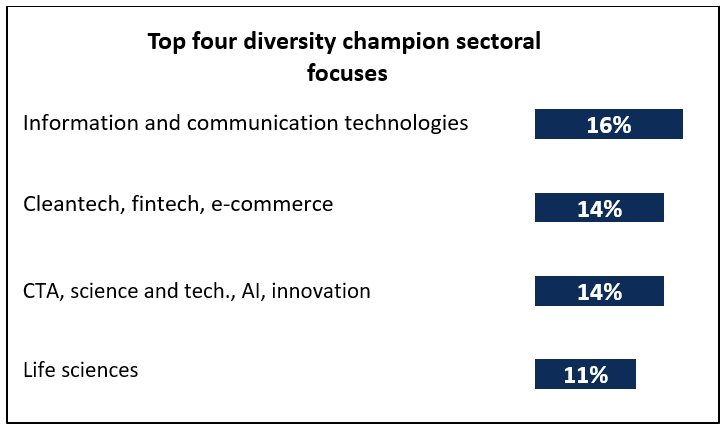
Text version
Top four Diversity Champions sectoral focuses:
- Information and communication technologies: 16%
- Cleantech, fintech, e-commerce: 14%
- CTA, science and tech., AI, innovation: 14%
- Life sciences: 11%
Source: Primary evaluation data
Figure 12:
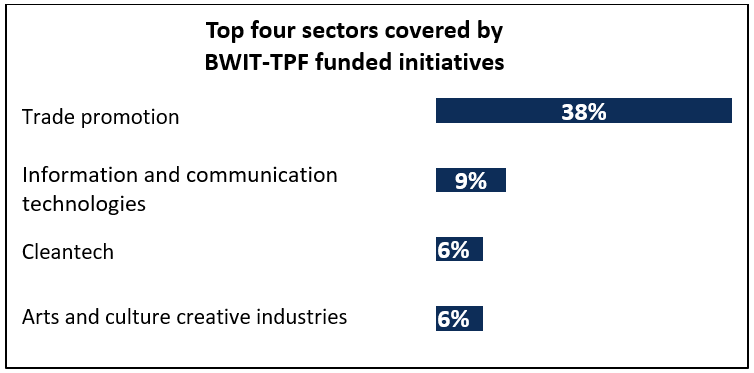
Text version
Top four sectors covered by BWIT-TPF funded initiatives:
- Trade Promotion: 38%
- Information and communication technologies: 9%
- Cleantech: 6%
- Arts and culture creative industries: 6%
Source: Global Affairs Canada. Results data. 2023
BWIT services were not designed to systematically align with the sectors in which women entrepreneurs were mostly concentrated, limiting the extent to which services could be targeted to this group.
BWIT services including diversity champions and their dedicated trade sectors, as well as BWIT-TPF funded initiatives, were not designed to systematically align with sectors in which women entrepreneurs are mostly concentrated. Diversity champions in regional offices and BWIT HQ staff noted a misalignment between the diversity champion role and their dedicated service sectors. Documentation and literature review indicated that women-owned businesses tend to specialize in consumer products, services, retail, beauty, food, health and culture, whereas men-owned businesses are more prevalent in the goods-producing, information and communication technologies, and infrastructure sectors. That said, the diversity champions’ top four sectoral focuses were (1) information and communication technologies (16%), (2) cleantech, fintech and e-commerce (14%), (3) Canadian Technology Accelerator (CTA), science and technology, artificial intelligence (AI) and innovation (14%) and (4) life sciences (11%). TCS guidelines categorized sectors as priority or non-priority, working proactively with priority sectors and reactively with non-priority. These priority and non-priority sectors were established by trade commissioners at regional offices and missions based on three factors: market opportunity, Canadian capability and Canadian interest to exploit a market. Over the evaluation period, many sectors in which women were most concentrated were non-priority, and services were therefore reactive.
In addition, there was limited data available regarding the sectors covered by BWIT-TPF-funded initiatives, as the sectors were not identified for a significant number of initiatives (i.e. 67 initiatives). Given this limitation, the evaluation team analyzed descriptions of these initiatives and additional information on Strategia to identify their most likely target sector. Of this new sample, comprising 102 initiatives funded by the BWIT-TPF between fiscal years 2018-19 and 2021-22, as shown in the chart to the left, the top four sectors were found to be: trade promotion (38%), information and communication technologies (9%), cleantech (6%) and arts and culture creative industries (6%). Therefore, BWIT-TPF-funded initiatives consisted mainly of trade promotion events (38%), which do not cover a specific sector, and business delegations targeting technology-related sectors (32%). Not tapping into the sectors in which women entrepreneurs were most concentrated was a missed opportunity to better tailor services and support women entrepreneurs in a systematic manner.
Performance measurement
Figure 13:

TRIO2 is the client relationship management system used by the Trade Commissioner Service (TCS) to manage its relationships and activities with Canadian businesses and key local contacts.
When trade commissioners (including diversity champions) input data regarding services provided to underrepresented entrepreneurs, TRIO2’s current options for data disaggregation include special characteristic "tags" for women-owned, Indigenous-owned, youth-owned and LGBTQ-owned businesses.
A new version (TRIO3) is currently under development, with the goal of improving the utilization and disaggregation of performance data.
Limitations in the collection, maintenance and extraction of disaggregated data impacted the performance measurement and implementation of the BWIT initiative.
The evaluation identified limitations in the collection and maintenance of disaggregated client data, and the extraction of disaggregated data from TRIO2 to target support to diversity clients. While the existence of special characteristics in TRIO2 was highlighted by many diversity champions as positive step towards data disaggregation (including the recent addition of a tag for LGBTQ+-owned businesses), the frequency and extent of special characteristic tag use within TRIO2 varied by diversity champion and regional office. Moreover, methods for obtaining self-identification data from clients and updating it over time lacked systematization, with some diversity champions using intake forms and others asking clients directly. One diversity champion updated the intake form used by their regional office to include additional questions for optional self-identification, but this change was not consistently applied across the regional office and did not extend to other offices. The absence of a policy for the systematized collection and maintenance of self-identification data left room for inaccuracy in BPE’s measurement of BWIT’s reach and performance over time.
In addition to the inconsistent collection and maintenance of disaggregated data, limitations in the extraction of this data from TRIO2 posed challenges for diversity champions seeking to target support to diversity clients. Although the TCS Tools, Analysis and Performance Division (BTB) - which provides overall performance management advice, guidance and coaching to offices abroad and in Canada - could generate custom datasets upon request, there was no way for diversity champions to directly extract information on services provided to businesses from TRIO2 based on businesses’ special characteristics. For instance, diversity champions were unable to extract lists of clients by underrepresented groups when recruiting for international events for the BWIT initiative. However, to improve efficiency in the use of disaggregated data to target diversity clients, some offices or diversity champions maintained their own dashboards (complementary to TRIO2) for managing diversity clients. This limited the ability to compare diversity client data across regional offices. Ongoing efforts to develop an updated version of TRIO2 (TRIO3) aim to improve the utilization and disaggregation of performance data.
Efficiency
Operational needs and funding
Figure 14:
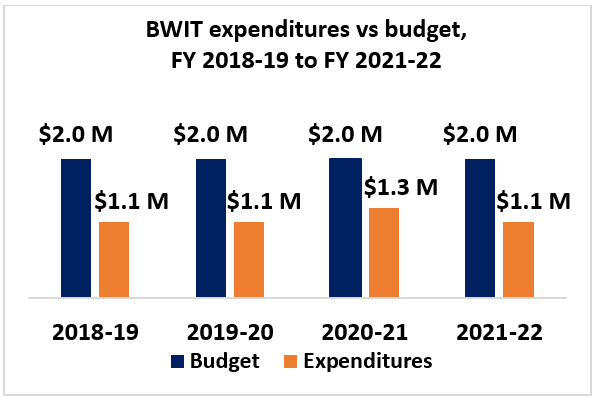
Text version
BWIT expenditures vs budget, FY 2018-19 to 2021-22
| Year | Budget | Expenditures |
|---|---|---|
2018-19 | $2.0M | $1.1M |
2019-20 | $2.0M | $1.1M |
2020-21 | $2.0M | $1.3M |
2021-22 | $2.0M | $1.1M |
Source: Global Affairs Canada. Results data. 2022
Figure 15:
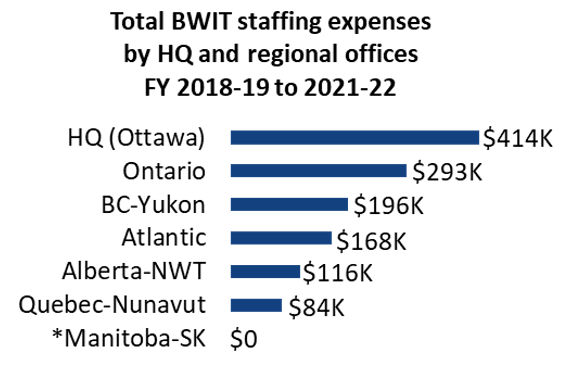
Text version
Total BWIT staffing expenses by HQ and regional offices FY 2018-19 to 2021-22
| Office | Total |
|---|---|
HQ (Ottawa) | $414K |
Ontario | $293K |
BC-Yukon | $196K |
Atlantic | $168K |
Alberta-Northwest Territories | $116K |
Quebec-Nunavut | $84K |
Manitoba-Saskatchewan | $0 |
*The Manitoba and Saskatchewan RO’s diversity champion position was fully funded by the TCS and not from BWIT funds.
Source: Global Affairs Canada. Financial data. 2022
The BWIT initiative consistently underspent allocated funds over the evaluation period, due to factors such as the non-permanent nature of BWIT-funded positions and the impacts of COVID-19.
The BWIT initiative disbursed a total of $4.6 million over its first four years (fiscal years 2018-19 to 2021-22), which represented 28% (or $1.3 million) for personnel at HQ and regional offices, and 72% (or $3.2 million) for operations, including the BWIT Trade Program Fund (BWIT-TPF). Total annual expenditures were consistently lower than the budgeted amount over the evaluation period, with this trend forecasted to continue into FY 2022-23. From FY 2018-19 to FY 2021-22, the average annual disbursement for operations and personnel were 44% and 59% lower than the budgeted amounts, respectively. BWIT’s budget included funding for six full-time equivalent diversity champion positions across regional offices, in addition to two full-time equivalent HQ-based positions. With each regional office managing BWIT funding for these positions based on their respective needs and priorities, annual expenditures for these positions varied widely both within and between the regional offices. For the same period, the BWIT-TPF’s annual disbursements were also consistently less than allocated amounts, with this trend forecasted to continue into FY 2022-23.
BWIT’s overall underspending can be linked to various factors including challenges with staffing BWIT-funded positions with non-permanent funding and impacts from the COVID-19 pandemic. Regional offices noted difficulties in attracting and maintaining talent for term positions funded by BWIT for the diversity champion role, due to their temporary nature and the priority given to indeterminate positions for skills development and promotion. A similar challenge was noted for rotational Foreign Service positions in the regional offices, with the perception that there are fewer opportunities for advancement in the regions than at HQ or in missions. BWIT spending was also affected by the direct and continued impacts of COVID-19 on TCS operations and staffing, as well as the planning and rollout of BWIT-TPF funded initiatives (e.g. the cancellation of business delegations and events). Although COVID-19 impacted the conduct of TPF-funded initiatives and limited BWIT spending capacity of allocated BWIT-TPF funds in fiscal years 2020-21 and 2021-22, it only partially accounted for BWIT-TPF underspending over the evaluation period. However, best available data showed that allocated BWIT-TPF funds remained largely unspent each year (on average 52% of allocated funds unspent annually), including the years prior to and following the major impacts of COVID-19. While data quality issues and limitations (including inconsistent reporting and data entry on returned and repurposed funds by missions and regional offices) prevented the identification of BWIT-TPF’s specific reasons for underspending, this situation was not unique to the BWIT-TPF; the best available data showed consistent underspending of allocated funds across all other TPFs during the evaluation period.
Conclusions
The evaluation found that the BWIT initiative’s relevance and improved performance following its 2018 decentralization demonstrated its value added within the Trade Commissioner Service and broader ecosystem of support to women entrepreneurs. The BWIT initiative was aligned with both the needs of business women in international trade and Government of Canada policy, and was complementary to other stakeholders within the broader ecosystem of support to women entrepreneurs. This relevance was accompanied by significant performance improvements after the initiative was decentralized into three components. The Inclusive Trade Promotion team at headquarters contributed to a more comprehensive approach to supporting women entrepreneurs by providing policy guidance within Global Affairs Canada and increasing the reach and awareness of Trade Commissioner Service support for women entrepreneurs through engagement with women’s business support organizations. The creation of the client-facing diversity champion role in regional offices fostered Trade Commissioner Service engagement with a wider subset of women and underrepresented entrepreneurs across Canada. The BWIT Trade Program Fund was fundamental in enabling missions to organize initiatives promoting inclusive international trade by supporting women entrepreneurs in accessing diverse markets.
Despite the BWIT initiative’s clear value added over the evaluation period, the evaluation found that the limited strategic direction provided by BPE to regional offices on the roles and responsibilities of diversity champions, exacerbated by the diversity champions’ direct accountability to management in their respective regional offices, contributed to ambiguity in how the role should address the distinct needs of business women in international trade. Guidance provided to the diversity champions included an information session on the BWIT file following decentralization and an internal Inclusive Trade Promotion wiki page with resources outlining Trade Commissioner Service support available to underrepresented entrepreneurs. However, the provision of resources through the wiki page was not accompanied by formalized guidance on the roles and responsibilities of diversity champions. The lack of clarity on diversity champion roles and responsibilities suggests a need for formalized guidance and adequate support throughout their engagement on how the role should address the distinct needs of women entrepreneurs pursuing international trade opportunities.
The evaluation also found that the BWIT Trade Program Fund selection process was not designed to systematically prioritize and align with the sectors in which women entrepreneurs were primarily concentrated. Initiatives funded by the BWIT Trade Program Fund consisted mainly of sector-agnostic trade promotion events and business delegations targeting technology-related sectors, where men-owned businesses were more prevalent, while women-owned businesses tended to specialize in consumer products, services, retail, beauty, food, health and culture. The absence of sectoral prioritization and alignment was a missed opportunity to better tailor BWIT Trade Program Fund initiatives and support women entrepreneurs in a systematic way.
Recommendations and considerations
Recommendations
- Formalize guidance and enhance support to regional offices on the diversity champion role and responsibilities in addressing the distinct needs of women entrepreneurs.
- Prioritize the selection of BWIT Trade Program Fund initiatives that align with the sectors in which women entrepreneurs are most concentrated.
Considerations
Trade Commissioner Service performance measurement of support to underrepresented entrepreneurs: Limitations in performance measurement practices, namely client self-identification and BWIT performance indicators, made it difficult to measure disaggregated results directly attributed to the BWIT initiative. Processes for collecting and maintaining client self-identification data varied across Trade Commissioners and were not systematized. The TRIO2 client relationship management system did not allow trade commissioners to directly extract services data based on client’s special characteristics, requiring additional processes to obtain disaggregated performance data needed to support clients. The Trade Commissioner Service could consider improving performance measurement by ensuring that appropriate data governance processes are in place for capturing disaggregated results data for underrepresented groups, including the use of targeted indicators.
Staffing and retention in regional offices of the Trade Commissioner Service: The regional offices noted difficulties in attracting and retaining talent for term positions funded by BWIT for the diversity champion role, due to their temporary nature and the priority given to indeterminate positions for skills development and promotion. A similar challenge was noted for rotational Foreign Service positions in the regional offices, with the perception that there are fewer opportunities for advancement in the regions than at headquarters or in missions. While these staffing challenges in the regional offices are among the factors that contributed to BWIT’s underspending, they speak to a wider and recurring challenge for the Trade Commissioner Service for staffing positions with non-permanent funding for various programs. The Trade Commissioner Service could consider developing mitigation strategies to increase staff stability in ROs and establishing permanent funding for diversity champion positions across regional offices to allow better financial planning, as well as corporate memory and staff retention.
Annexes
Annex 1: Top 10 missions by BWIT-TPF allocated funds, FY 2018-19 to 2021-22
| Abbreviation | Mission |
|---|---|
LNGLS | Consulate General of Canada in Los Angeles |
DUBAI | Consulate General of Canada in Dubai |
PARIS | Embassy of Canada to France |
CNGNY | Consulate General of Canada in New York |
BRLIN | Embassy of Canada to Germany |
CHCGO | Consulate General of Canada in Chicago |
WSAW | Embassy of Canada to Poland |
MIAMI | Consulate General of Canada in Miami |
PALTO | Consulate General of Canada in Palo Alto |
TOKYO | Embassy of Canada to Japan |
Figure 16:
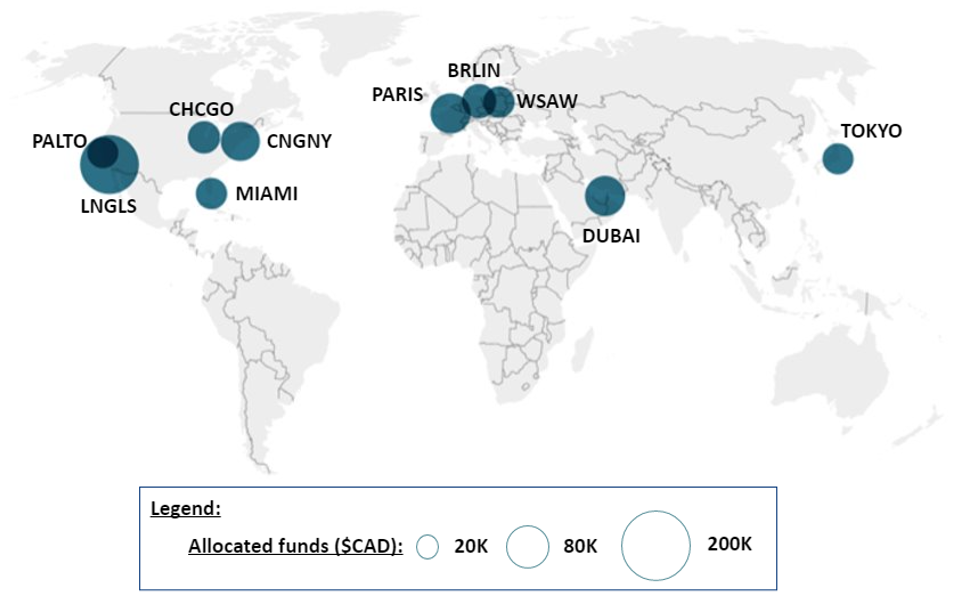
Text version
Map presenting the top 10 missions around the world according to size of BWIT-TPF allocated amount, FY 2018-19 to 2021-22: LNGLS 200K; CNGNY, Dubai and PARIS 80K; BRLIN, CHCGO, MIAMI, PALTO, TOKYO and WSAW 20K.
Source: Global Affairs Canada. Results data. 2022
Annex 2: BWIT-TPF-approved initiatives across missions abroad
Between FY 2018-19 and FY 2021-22, 102 initiatives across 48 missions were approved for BWIT-TPF funding, ranging in value from $1,200 to $45,000.
Figure 17:
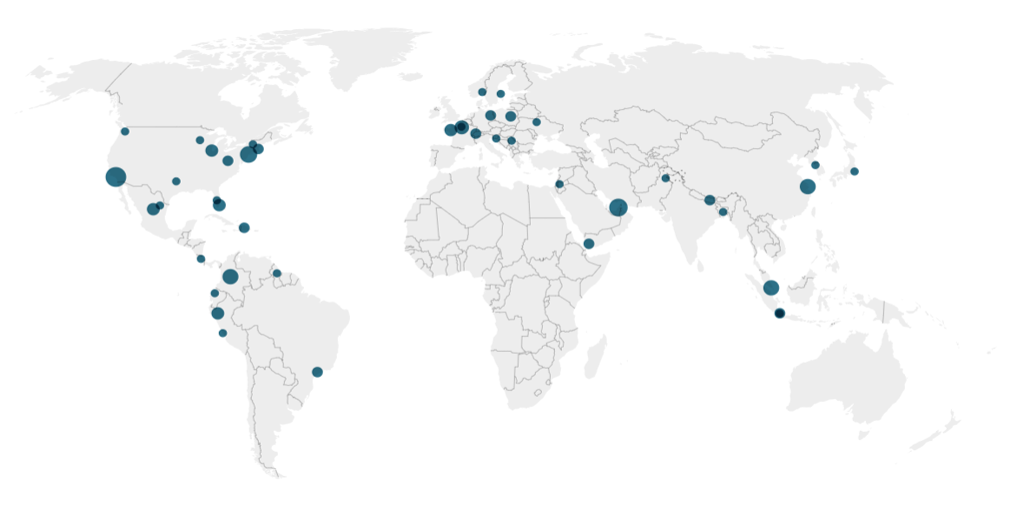
Text version
Map of the missions around the world with BWIT-TPF approved initiatives.
Source: Global Affairs Canada. Results data. 2022
Annex 3: Feminist evaluation approach
Figure 18:
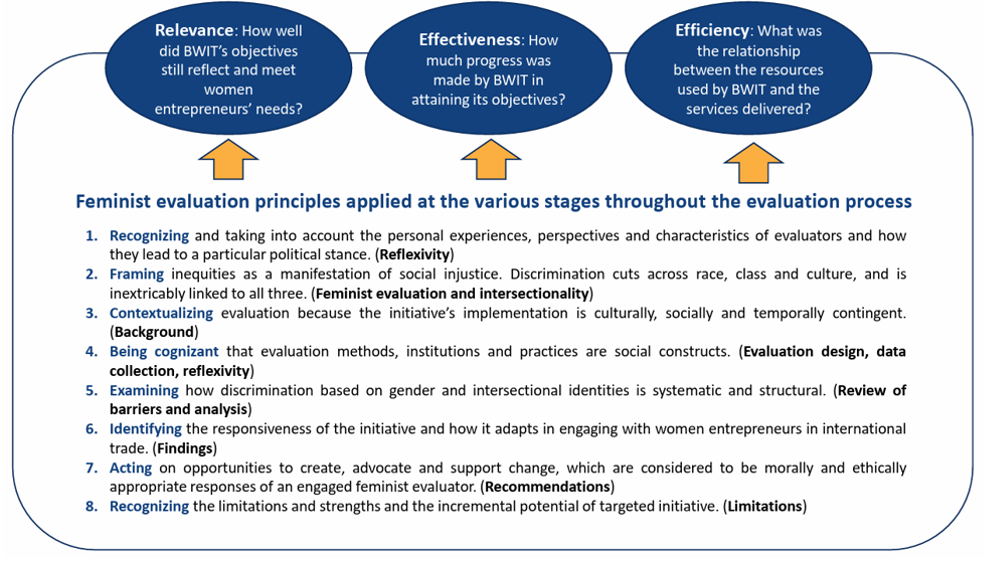
Text version
Feminist evaluation principles applied at the various stages throughout the evaluation process
- Recognizing and taking into account the personal experiences, perspectives and characteristics of evaluators and how they lead to a particular political stance. (Reflexivity)
- Framing inequities as a manifestation of social injustice. Discrimination cuts across race, class and culture, and is inextricably linked to all three. (Feminist evaluation and intersectionality)
- Contextualizing evaluation because the initiative’s implementation is culturally, socially and temporally contingent. (Background)
- Being cognizant that evaluation methods, institutions and practices are social constructs. (Evaluation design, data collection, reflexivity)
- Examining how discrimination based on gender and intersectional identities is systematic and structural. (Review of barriers and analysis)
- Identifying the responsiveness of the initiative and how it adapts in engaging with women entrepreneurs in international trade. (Findings)
- Acting on opportunities to create, advocate and support change, which are considered to be morally and ethically appropriate responses of an engaged feminist evaluator. (Recommendations)
- Recognizing the limitations and strengths and the incremental potential of targeted initiative. (Limitations)
Relevance: How well did BWIT’s objectives still reflect and meet women entrepreneurs’ needs?
Effectiveness: How much progress was made by BWIT in attaining its objectives?
Efficiency: What was the relationship between the resources used by BWIT and the services delivered?
Source: Adapted from D. Podems. Making Feminist Evaluation Practical. 2021
Annex 4: International scan
An international scan of national government initiatives identified BWIT as one of the few and oldest national-level initiatives supporting women entrepreneurs in international trade. The scan identified relevant initiatives in the United States, Ireland, New Zealand and ChileFootnote 1, most of which were created in recent years.
The objective of this scan was to identify approaches and relevant practices among peer countries for supporting women in international trade. It relied on interviews, consultations, and document review. It did not focus on results, which were often difficult to assess since most of the sampled initiatives were launched in recent years.
- United States: The U.S. Commercial Service’s Global Diversity Export Initiative (GDEI) helps African-American, Asian-American, Hispanic-American, Native American, veteran and service-disabled veteran, women and LGBTQI+ businesses to identify export opportunities, access financing and connect with international buyers and partners. Created following the U.S. Government’s 2021 Executive Order (13985) on advancing racial equity and support for underserved communities through the federal government, the initiative is implemented through the U.S. Commercial Service’s global network of trade experts in over 100 U.S. cities and 80 countries. It also works with national business support organizations as strategic partners.
- Ireland: Enterprise Ireland launched its Action Plan for Women in Business in 2020 following a review of its support to women entrepreneurs. With the action plan’s first objective, Enterprise Ireland—the government organization responsible for the development and growth of Irish enterprises in world markets—aims to double the number of women-led companies growing internationally by 2025. Enterprise Ireland uses its annual business survey to collect and maintain gender disaggregated client data, which includes a gender breakdown of businesses’ employee numbers, senior leadership team and board composition. This provides it with baseline data for each firm against which it can measure progress in gender parity.
- New Zealand: New Zealand Trade and Enterprise (NZTE)—the government’s international business development agency—created the Women in Export Lead role in 2021 to inspire and support more women-led businesses in their global journeys. In line with the government’s Trade for All Agenda, it aims to double the number of women leaders in its Focus portfolio of 1,400 export companies that it actively supports. NZTE has focused on three strategic pillars of work for this role: 1. Gathering stories and statistical data; 2. Facilitating experiences that make space for women and create safe spaces for sharing and learning; and 3. Finding and supporting external partners as well as creating bridges within NZTE.
- Chile: ProChile—an institution of Chile’s Ministry of Foreign Affairs promoting Chilean goods and services exports—created the Mujer Exporta (Women Export) program in 2016 to enhance the participation of women in international trade. Targeting women-led businesses who are exporters or have export potential, the program’s activities fall within three key lines of work: training, networking and empowerment, and commercial promotion. To reduce information barriers for women, ProChile and its 56 offices abroad provide workshops, business round tables and contacts with foreign buyers. Eligibility is based on established criteria for “women led” businesses, which the program validates based on legal documents.
Annex 5: List of sources
Background
- CanExport SMEs – Applicant’s Guide. Date modified: February 2023
- Equality Growth: A Strong Middle Class. Finance Canada. 2018
- Inclusive Trade Promotion Brief. TCS Wiki. March 2022
- Now is the Time to Diversify Canada’s Export Markets. Trade Commissioner Service. Date modified: 2022
- SME Profile: Ownership Demographics Statistics 2022, ISED. 2022
- The State of Women’s Entrepreneurship in Canada, 2020. Women Entrepreneurship Knowledge Hub (WEKH). 2020
- The State of Women’s Entrepreneurship in Canada, 2021. WEKH. 2021
- The State of Women’s Entrepreneurship in Canada, 2022. WEKH. 2022
- Women Entrepreneurship Strategy website. ISED. Date modified: January 2023
- Women-owned SMEs and Trade Barriers. Julia V. Sekkel, 2020
Findings – Relevance – Trade-related needs and barriers
- Inclusive Trade Promotion wiki page – Youth Backgrounder. Global Affairs Canada. December 2021
- Inclusive Entrepreneurship – Exploring the Barriers Facing Black Entrepreneurs in Canada. 2021
- SME Profile: Ownership Demographics Statistics 2022, ISED. 2022
- The State of Women’s Entrepreneurship in Canada, 2020. WEKH. 2020
- The State of Women’s Entrepreneurship in Canada, 2021. WEKH. 2021
- The State of Women’s Entrepreneurship in Canada, 2022. WEKH. 2022
- Women-owned SMEs and Trade Barriers. Julia V. Sekkel. 2020
Findings – Relevance – Policy alignment
- Building a Diverse and Inclusive Public Service: Final Report of the Joint Union/Management Task Force on Diversity and Inclusion. Date modified: January 2018
- BWIT evaluation: OGD documentation review, including documentation from Agriculture and Agri-food Canada (AAFC), Business Development Bank of Canada (BDC), Canadian Northern Economic Development Agency (CanNor), Canadian Commercial Corporation (CCC), EDC, Federal Economic Development Agency for Northern Ontario (FedNor), Farm Credit Canada (FCC), Indigenous Services Canada (ISC), ISED, National Research Council Canada (NRC), Public Services and Procurement Canada (PSPC), Statistics Canada, Women and Gender Equality Canada. 2022
- Canada’s Inclusive Approach to Trade. Government of Canada. Date modified: February 2023
- Diversifying Canada’s Trade and Investment Opportunities. Trade Commissioner Service. Date modified: March 2020
- Export Diversification and Canada’s Major Trading Partners. Trade Commissioner Service. Date modified: May 2022
- The State of Women’s Entrepreneurship in Canada, 2022. WEKH. 2022
- Trade Diversification webpage. EDC. Date modified: May 2019
- Women Entrepreneurship Strategy. ISED. Date modified: January 2023
- Women-owned Exporting Small and Medium Enterprises. Bélanger-Baur, A. A. GAC. 2019
- Women Entrepreneurship Strategy ADM Steering Committee Terms of Reference. 2019
Findings – Relevance – Government of Canada complementarity
- BWIT evaluation: BWIT documentation review. 2022
- BWIT evaluation: GAC general documentation review. 2022
- BWIT evaluation: OGD documentation review, including documentation from AAFC, BDC, CanNor, CCC, EDC, FedNor, FCC, ISC, ISED, NRC, PSPC, StatsCan, WAGE. 2022
- BWIT evaluation: TCS similar initiatives documentation review. 2022
- Inclusive Women Venture Capital Initiative. ISED. 2022
- The State of Women’s Entrepreneurship in Canada, 2020. WEKH. 2020
- The State of Women’s Entrepreneurship in Canada, 2021. WEKH. 2021
- The State of Women’s Entrepreneurship in Canada, 2022. WEKH. 2022
- WES Steering Committee Terms of Reference. WES, ISED. 2019
- Women Entrepreneurship Strategy. ISED. Date modified: January 2023
Findings – Results and delivery – BWIT performance
- BWIT key performance indicators. BPE, GAC. 2022
- BWIT-TPF. Financial Data. Strategia Commercial. GAC. Accessed February 2023
- BWIT-TPF Financial Performance Data (BETA). GAC. Accessed February 2023
- Canadian delegation photo, Go for the Greens. 2022
- Results data. 2022
- Go for the Greens 2022. Go for the Greens – Success Through Synergy Since 2007. 2022
- Go for the Greens 2022 Participant Survey. TCS, GAC. October 2022
Findings – Results and delivery – Delivery model shift – HQ
- Awards Ceremony. WBE Canada Conference. 2022
- BPE annual reports. Document Review. 2022
- BPE engagement with GAC policy divisions. BPE, GAC. 2023
- BSC CanExport programs. GAC. Accessed February 2023
- BWIT evaluation: women’s support organization document review. 2023
- BWIT evaluation interviews. 2022
- Case study report: BWIT’s HQ Support Role. February 2023
- Draft tool kit for BWIT Trade Commissioners in regional offices. IBPE, GAC. 2019
- Go for the Greens 2022 Participant Survey. Trade Commissioner Service, GAC. 2022
- Inclusive Trade Promotion wiki page. BPE, GAC. Accessed January 2023
- Tools of the Trade Session. WBE Canada Conference, moderated by BPE’s deputy director. 2022
Findings – Results and delivery – Delivery model shift – Diversity champions
- BWIT documentation review. BPE, GAC. 2022
- BWIT evaluation interviews. 2022
- BWIT key performance indicators. BPE, GAC. August 2022
- Draft tool kit for BWIT Trade Commissioners in regional offices. BPE, GAC. 2019
- Results data. 2022
- Inclusive Trade Promotion wiki page. BPE, GAC. Accessed January 2023
- Preliminary Findings Paper: Impacts of Change in Delivery Model. Evaluation Division, GAC. June 2022
Findings – Results and delivery – Delivery model shift – BWIT’s Trade Program Fund
- BWIT TPF Criteria. Accessed February 2023
- BWIT client-facing website. Date modified: February 2022
- BWIT-TPF Financial Data. Strategia Commercial. Accessed February 2023
- BWIT-TPF Financial Performance Data. Accessed February 2023
- BWIT evaluation interviews. 2022
- Case study report: BWIT’s Trade Program Fund. February 2023
- Inclusive Trade Promotion: TPF wiki page. Accessed February 2023
- TCS Trade Funds Guidelines. Client Service Fund, Integrative Trade Strategy Fund, TPF. Date modified: March 2022
Findings – Results and delivery – Sectors of focus
- BWIT evaluation interviews. 2022
- BWIT-TPF Financial Data. Strategia Commercial. GAC. Accessed February 2023.
- BWIT-TPF Financial Performance Data. GAC. Accessed February 2023.
- BWIT-TPF initiatives data from 2018 to 2023. BPE, GAC. December 2022
- Case study report: BWIT’s Trade Program Fund. February 2023.
- Case study report: BWIT’s Diversity Champions. February 2023.
- Inclusive Trade Champions Survey, Preliminary Findings Paper. June 2022.
- Reports – BWIT-TPF Funded Events, Inclusive Trade Promotion wiki page. Accessed February 2023
- Strategia data base. GAC. 2023
- Trade Sectors page, Trade Sectors Bureau. GAC intranet. Date modified: July 2022
Findings – Results and delivery – Performance measurement
- BWIT evaluation interviews. 2022
- BWIT Key Performance Indicators. BPE, GAC. August 2022
- Results data. 2022
- TRIO2 web portal, GAC. Accessed February 2023
Findings – Efficiency – Operational needs and funding
- BWIT actuals and transfers and forecast FY 2018-19 to FY 2022-23. December 2022
- BWIT evaluation interviews. 2022
- BWIT-TPF financial data. Strategia Commercial. GAC. Accessed February 2023
- BWIT-TPF financial performance data. GAC. Accessed February 2023
TCS regional network audit. Management Audits Division (VBB), GAC.
- Date modified: